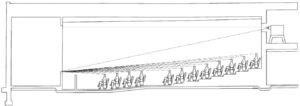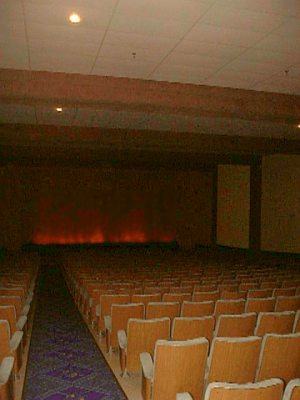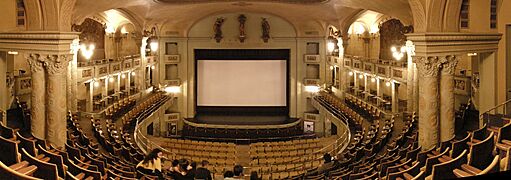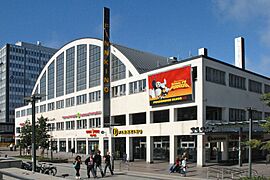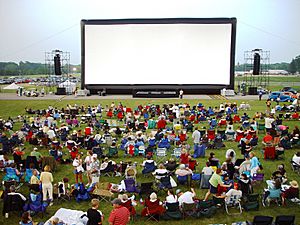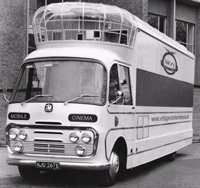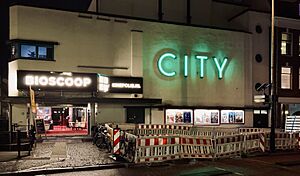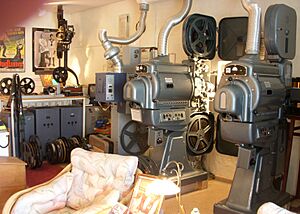Movie theater facts for kids
A movie theater (also called a cinema or movie house) is a place where people go to watch films on a big screen. It's a business that has special rooms called auditoriums where movies are shown for everyone to enjoy. Most movie theaters sell tickets for you to watch the film.
In a movie theater, a special machine called a movie projector shines the film onto a large projection screen at the front of the room. The sounds, like talking, music, and special effects, come out of speakers placed around the room. Since the 2010s, most movie theaters use digital cinema projectors, which means they don't need heavy film reels anymore.
Movie theaters show all kinds of films, from fun animated movies to big action-packed blockbusters and interesting documentaries. Some small theaters have just one screen, but most modern ones have many screens. The biggest places, called multiplexes, can have up to thirty screens! People usually sit on comfy padded seats that are often on a sloped floor, so everyone can see the screen clearly. Movie theaters also sell yummy snacks like popcorn, soft drinks, and candy. Some even sell hot food or drinks for adults.
Contents
What We Call Them
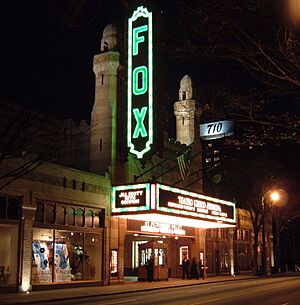
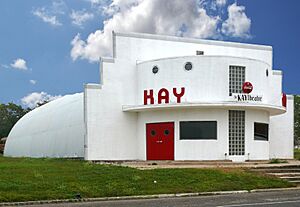
In countries like the United States, people often say "movie theater" or "theater." In places like the United Kingdom, Canada, and Australia, "cinema" is more common. You might also hear "movie house," "film house," or "picture house." The word "cinema" comes from a Greek word meaning "movement," which makes sense for moving pictures!
Sometimes, people use fun nicknames for movie theaters or movies themselves, like "the big screen" (because it's much bigger than a TV at home) or "the pictures."
How Movie Theaters Started
Early Shows
Before movies, there were other kinds of shows that used projected images. In the late 1700s, a show called "Phantasmagorie" used magic lanterns to project spooky ghost images.
In the 1800s, places like The Royal Polytechnic Institution in London had popular magic lantern shows. They used big lanterns to project detailed images onto huge screens, often with music and stories. Some shows even made images appear to move!
First Movie Screenings
The very first public movie showings happened in places that already existed, like vaudeville theaters or other rooms that could be made dark.
In Paris, from 1892 to 1900, a man named Émile Reynaud showed his animated movies using a system called "Théâtre Optique." He had over 12,800 shows for more than 500,000 people!
In 1894, the first place just for watching movies opened in New York City. It had ten machines called kinetoscopes, where you could look into a peep box to see a short film.
The first time films were shown to a paying public using a projector was in Berlin in November 1895. Soon after, in December 1895, the famous Lumière brothers showed their films in Paris using their "Cinématographe" system.
First Dedicated Movie Buildings
As movies became more popular, people started building places just for showing films. The first building made specifically for movies was in Atlanta, Georgia, in 1895.
In the United States, many small, simple theaters opened in converted shops. They usually charged five cents to get in, so they were called nickelodeons. These were very popular from about 1905 to 1915.
The Korsør Biograf Teater in Denmark, which opened in 1908, is the oldest movie theater still showing movies today!
-
A small still-active Kino Juha movie theatre in Nurmijärvi, Finland, opened in 1958
-
Regent Theatre in Hokitika, New Zealand
How Theaters Are Designed
A movie theater usually has one big room (or many rooms) with rows of comfy seats. There's also a lobby where you can buy tickets at the box office and get snacks and drinks at the concession stand. You'll often see movie posters and sometimes even arcade games in the lobby.
Many older theaters had a balcony, which is an elevated seating area above the main floor. Modern theaters often use "Stadium seating" where the rows are sharply sloped upwards from the screen. This design, which has been around since the 1920s, helps everyone see over the heads of the people in front of them.
Rows of seats are separated by aisles, usually with steps and small lights to help you find your way in the dark. Theaters often have booster seats for younger kids to sit higher. Modern theaters also have special areas for people using wheelchairs.
-
Cinema Odeon auditorium in Florence
-
Interior of Hoyts cinemas auditorium in Perth, Australia, with stadium seating and acoustic wall hangings.
-
Tennispalatsi, a major Finnkino multiplex in Helsinki, Finland
Multiplexes and Megaplexes
A multiplex is a movie theater with many screens, usually six or more, all sharing one lobby. The idea for multiplexes started in Canada in the 1950s. The first one in the United States opened in 1963.
Since the 1960s, having multiple screens has become normal. Many old, large movie theaters were even divided into smaller rooms to create more screens. Multiplexes are popular because they offer many different movies and showtimes in one place.
A very large multiplex with 20 or more screens is sometimes called a "megaplex." The first megaplex opened in Belgium in 1988 with 25 screens!
Drive-in Theaters

A drive-in movie theater is an outdoor parking area with a giant screen. People drive their cars in, park, and watch the movie from inside their car. The sound usually comes through their car radio. Drive-ins are mostly found in the United States and were very popular in the 1950s and 1960s. They usually only operate when the weather is good and after the sun sets.
Other Places to Watch Movies
Sometimes, movies are shown outdoors in parks or on the walls of buildings. Colleges often show movies in their lecture halls. In the past, there were "video-salons" where people watched movies on big TVs in small rooms.
Movies are also shown on airplanes and trains, either on large screens for everyone or smaller screens for each seat. The smallest movie theater ever built is the Cabiria Cine-Cafe in Brazil, which is only 24 square meters and seats 18 people! There's even a solar-powered mobile cinema in the UK that fits 8-10 people inside a converted caravan.
Special Movie Experiences
3D Movies
3D movies make images look like they are popping out of the screen and have depth. To see them, you wear special glasses, usually polarized glasses. These glasses send a slightly different image to each eye, which tricks your brain into seeing depth.
3D movies first appeared in the 1920s and had a big moment in the 1950s when they were a way to offer something you couldn't get on TV. They became popular again in the 2010s, especially with animated films from companies like Disney and Pixar. Many theaters now have 3D screens, and sometimes there's a small extra fee for 3D tickets.
IMAX
IMAX is a special movie system that uses very large film (much bigger than regular film) and huge screens. IMAX theaters have special projectors and screens that are much taller and wider than normal. The first permanent IMAX theater opened in Toronto, Canada.
IMAX also has a digital system that uses two high-resolution projectors and a slightly different screen shape. In 2015, IMAX introduced "IMAX with Laser," which uses even clearer laser projectors.
Premium Large Format (PLF)
"Premium large format" (PLF) refers to movie rooms that offer a super high-quality experience. These aren't just one type of screen, but a combination of great features like:
- Very large "wall-to-wall, floor-to-ceiling" screens.
- Super clear 4K resolution images.
- Laser projection for bright, vibrant colors.
- Advanced surround sound systems like Dolby Atmos that make sound come from all around you.
- Really comfy seats, often leather recliners.
Many movie theater companies have their own special names for their PLF screens, like "Prime," "XD," or "Epic." These screens offer a top-notch way to watch movies and compete with other special formats like digital IMAX.
Motion Controlled Seating
Some theaters have special seats that can move and vibrate along with the action on the screen. This technology, called D-BOX, makes you feel like you're part of the movie!
How Movies Are Shown
Usually, when you buy a ticket, it's for one main movie. Sometimes, theaters show two movies for one ticket, called a "double feature," with a short break in between.
In the early days of movies, theaters would show many short films before the main movie, like newsreels, cartoons, or short comedies. Today, before the main movie starts, you'll usually see commercials and then "trailers" (previews) for upcoming movies.
Some very long movies might have a short break, called an intermission, in the middle. After the movie, the closing credits roll, showing everyone who worked on the film. Sometimes, there are extra scenes during or after the credits, which are fun to watch!
Before the movie begins, theaters often show slides or videos reminding people about theater rules, like turning off cell phones and not recording the movie.
Live Shows in Theaters
Sometimes, movie theaters use their digital projectors to show live events, like operas, concerts, or sports games. These are broadcast directly to the theater, and the tickets might cost more than a regular movie ticket.
Getting Into the Movie

To get into a movie theater, you buy a ticket from the box office. Sometimes you can pick a specific seat, and other times it's "open seating," meaning you can sit anywhere available. Many theaters now let you buy tickets online or at machines in the lobby.
Movie ticket prices can change. They might be cheaper during the day or on weekdays (like "cheap Tuesday" in some countries) and more expensive in the evenings or on weekends. Kids, students, and seniors often get discounted tickets. Some theaters also offer special passes for unlimited movies for a monthly fee.
Luxury Screens

Some movie theaters offer a "luxury" experience. These might have super comfy reclining leather seats, free refills on snacks, and even a menu where you can order food and drinks (including for adults) right to your seat.
Age Restrictions
Movies often have a rating system that suggests or requires age limits. This is usually because of things like violence or mature themes. Depending on the rating, younger kids might not be allowed to see certain movies, or they might need an adult with them. Movie theaters follow these rules to make sure movies are shown to the right audiences.
Movie Theater Companies
Many movie theaters are part of large companies that own many theaters. In North America, some of the biggest chains are Regal Cinemas, AMC Theatres, and Cinemark Theatres. In Canada, Cineplex Cinemas is the largest.
Around the world, you'll find big chains like Wanda Cinemas in China, PVR INOX in India, and Cineworld and Odeon in Europe. These companies manage thousands of screens and bring movies to millions of people.
See also
 In Spanish: Sala de cine para niños
In Spanish: Sala de cine para niños
- Cinema etiquette
- Film poster
- Film screening
- Home cinema
- Inflatable movie screen
- List of drive-in theaters
- List of movie theaters
- Mini theater
- Movie palace
- Multiplex (movie theater)
- Nickelodeon (movie theater)
- Saturday morning pictures




